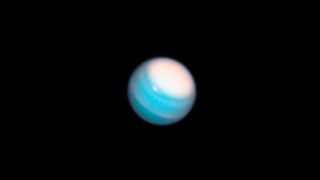Uranus will vanish during 'lunar occultation' Wednesday night
For three hours on Sept. 14, Uranus will simply disappear.

Depending on where in the world you'll be Wednesday night (Sept. 14), you may be able to see Uranus disappear. (Don't worry; it'll be back again a few hours later.)
On Wednesday, the sixth planet from the sun will appear to pass directly behind Earth's moon, going completely out of sight for three and a half hours. The great disappearing act, also known as the lunar occultation of Uranus, begins around 4:41 p.m. ET (2041 GMT) and ends by 8:11 p.m. ET (0011 GMT on Sept. 15), according to In-the-sky.org. However, only viewers in Europe, northern Africa and western Asia will be at the exact right angle to see the illusion work.
Viewers in these regions will still need binoculars or a telescope to see the show, as Uranus is not a naked-eye planet. (Check this map, courtesy of In-the-sky.org, to see which regions will have the best view.)
If you are not in one of those places or you don't have a telescope, don't fret; you can watch the occultation live from Rome thanks to the Virtual Telescope Project, which will begin streaming the event at 4:45 p.m. ET (2045 GMT).
Occultation refers to any astronomical event in which one object appears hidden behind another. This phenomenon is slightly different from an eclipse, which occurs when one object casts its shadow directly onto another – such as when the moon's shadow falls over Earth during a solar eclipse.
From Earth, lunar occultations are the most commonly seen, as the moon looms so large in our sky. However, the moon's close proximity to Earth also means that its position in the sky may appear slightly different depending on which part of the planet you're watching from. As such, all lunar occultations are visible only to narrow swaths of the world that happen to have the exact right viewing angle.
Fortunately, these events are frequent, so another lunar disappearing act is always just around the corner. The last lunar occultation of Uranus that was visible from the United States and Canada occurred just last month, on Aug. 18, Live Science's sister site Space.com reported. Uranus emerged triumphant on that night, and it surely will tomorrow, as well.
Sign up for the Live Science daily newsletter now
Get the world’s most fascinating discoveries delivered straight to your inbox.
Originally published on Live Science.

Brandon is the space/physics editor at Live Science. His writing has appeared in The Washington Post, Reader's Digest, CBS.com, the Richard Dawkins Foundation website and other outlets. He holds a bachelor's degree in creative writing from the University of Arizona, with minors in journalism and media arts. He enjoys writing most about space, geoscience and the mysteries of the universe.
Most Popular

